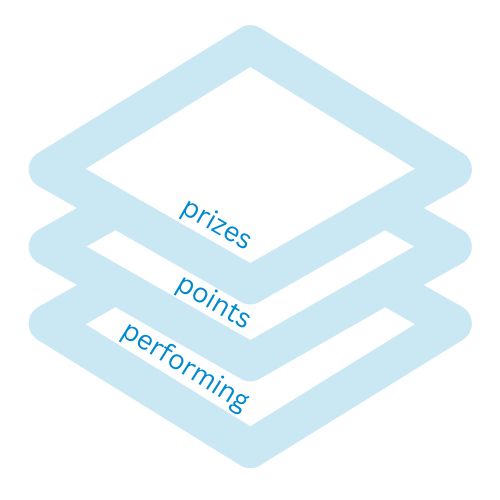It’s time to reward progression and consistency as well as results

Have you ever struggled to get the motivation to do things that are just not fun or do not give you any obvious reward. I’m talking about things like
- cleaning a sink (you could argue that you have a nice shiny sink but big deal)
- creating a blog post once a week
- producing a YouTube video once a day
- preparing your tax return (the only reason to do it is to avoid fines and prison!)
- clearing out the spare room (just close the door and pretend it isn’t there!)
- a sales call
- eating healthy food
Now, in some cases you can “gamify” it or make the tasks more fun but the more I think about it, seeing if you can clean a sink in under 10 minutes might be a fun challenge to some but it still doesn’t make me want to do it. And if it doesn’t motivate you to clean your entire home then read on!
You may also be interested to learn that you don’t have unlimited discipline and motivation – it runs out when constantly challenged. And while you can increase these through regular training in uncomfortable activities (ice baths, lifting weights, running great distances etc), you can also avoid using up too much of your daily quota by making dull or challenging tasks more palatable.
Give yourself credit
Now what if the dull task you did resulted in some reward?
And what if you could build up tasks for bigger rewards?
In marketing, the consistent (but tedious) production of videos, blog posts and social media memes will get you the results in the long term but you can lose the will to live if you’re just starting out and after a month of daily posting, you’re still seeing zero clients.
But if you gave yourself 1 point for every post you made and over the course of a month you built up 30 points, all you need to do now is to figure out what 1 point is worth to you.
How rewarding is that!?
Looking at rewards for points, you just need to come up with a list of things that you can “buy” for points.
The value of the points, is, of course, determined by how hard it is to get points.
I would reward creating one article (such as this one) exactly 1 point. Same goes for making a blog article.
As for something like a tax return, the form is divided into parts, so you could reward yourself 1 point for each part that you complete. 5 parts? 5 points.
It’s not an exact science but it will make doing things more interesting than doing tasks for no reward whatsoever simply because “you have to do it”.
And the end result is that you end up wanting to build up points.
What do points make? Prizes!
So what exactly is a point worth? The way I’ve done things is to allocate points simply 1 for 1. So if I earn 1 point, it means I can watch 1 episode of a box set or read 1 chapter of a “non-work” book (I tend to read a lot of business and psychology books which comes under the “work” category – because I enjoy it, I don’t reward myself for it!).
There are plenty of grey areas and it’s something you’ll need to customise for yourself, taking on board the notion of not making it too difficult to get a point but not making it too easy, whilst also not making the points equate to crazy prizes (eg one blog article does not equate to going on holiday for a week!).
Furthermore, you could add milestones so if you rack up 100 points, you could reward yourself with something more substantial such as a trip to the theatre.
Here’s an example of what I’ve done, using a spreadsheet to tally up points. I call the points Action Points.

The first number is the APs available to spend. The second number is the total earned from the start. When I hit milestones eg 100, 200, 500, 1000, I can opt to reward myself something extra for staying the course.
Benefits
So you can see there are some useful benefits to gamifying your life:
- Makes you more consistent
- Encourages action
- Keeps you moving forward/progressing
- You feel more positive about tasks and activities you dislike
Summary
In brief, think about the 3 Ps of Gamification: Performing -> Points -> Prizes.
And now it’s your turn so have a play, customise it to suit, and of course, notice how it feels. I’ve noticed that I’m more open to do tasks that I previously would put off doing. And even eager to do some things that I did grudgingly.
See how it works for you and let me know!
Sciencey appendix
I’m not going to bore you with the science but there’s strong evidence to suggest that motivation and discipline is limited even if you’re considered highly disciplined or very motivated, so it runs out no matter what.
And then all hell can break loose especially if you’re sticking to some kind of diet or fitness routine!
This is why gamification is useful. It means you require less discipline and motivation so they last longer, and you achieve more… with more ease!
Also, as well as gamification, motivation and discipline the above article touches on flow states.
There is an argument that extrinsic motivation (external rewards such as prizes) are not as good as intrinsic motivation (internal drive such as the benefits or the Why) and can result in failure.
-certainly, if you can find the intrinsic reward to publish one blog post a week and keep going for 5 years, that’s great – crack on!
-extrinsic motivation means you stop doing it when the rewards stop which is not so good for developing a skill or behaviour – the focus on this article is about getting stuff done that you would rather not do
Anyway, if you want to learn more about any of this, just hit Google. There are plenty of articles written by professors on these areas of psychology.
Maybe you can give yourself a point for every article you read.

